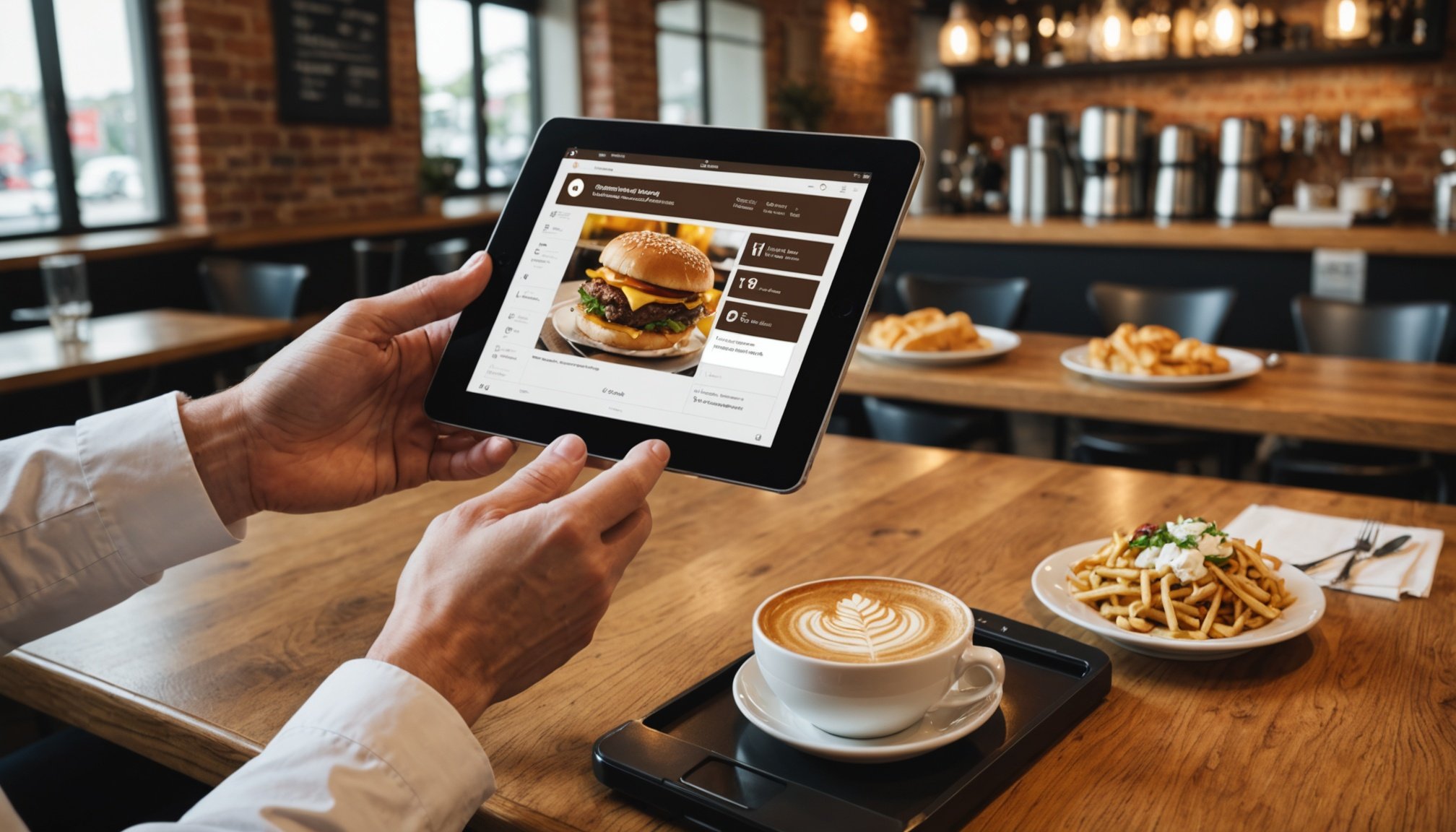Transforming Café Orders: Cutting-Edge Technology for a Smooth, Effortless Experience
In the fast-paced world of the restaurant industry, technology is revolutionizing the way we order and enjoy our food. From self-service kiosks to AI-driven personalization, the latest innovations are transforming the dining experience, making it more efficient, personalized, and satisfying for customers. Here’s a deep dive into how these cutting-edge technologies are reshaping the way we interact with restaurants.
The Rise of Self-Service Kiosks
Self-service kiosks have become a staple in many fast-food restaurants and cafes, and their popularity is on the rise. By 2023, over 43% of establishments worldwide had installed around 350,000 kiosks, a number expected to double by 2028[1].
In parallel : Eco-Friendly Tips to Help Restaurants Slash Their Carbon Footprint
Benefits for Restaurants and Customers
These kiosks offer a multitude of benefits for both businesses and customers. Here are some key advantages:
- Reduced Wait Times: Self-service kiosks significantly reduce the time customers spend waiting in line. With multiple kiosks, restaurants can handle a higher volume of orders without increasing staff numbers[4].
- Increased Efficiency: Kiosks automate the order-taking process, allowing staff to focus on food preparation and customer service. This integration with kitchen display systems (KDS) and point of sale (POS) systems ensures orders are transmitted directly to the kitchen, minimizing errors and enhancing operational efficiency[2][3].
- Enhanced Customer Experience: Kiosks provide an interactive and autonomous way for customers to place orders. They can browse menus at their own pace, select items, and make payments without the need for staff assistance. This autonomy enhances customer satisfaction and reduces the likelihood of mistakes[2].
Real-World Success
A case study by Otter highlights the success of IDK Philly, a restaurant that implemented kiosk technology. The owner, Reda Labbakh, noted a significant reduction in wait times and errors, along with an increase in customer satisfaction. “The kiosks have been a game-changer for us. Customers love the ease of use, and it’s helped us manage our orders more efficiently,” he said[1].
Also read : Elevating Dining Delights: Harnessing Customer Insights to Perfect Restaurant Menus
Innovations Driving the Future of Fast Food Kiosks
The future of kiosks is marked by several exciting innovations that are set to further enhance the customer experience and operational efficiency.
AI-Powered Personalization
AI algorithms are being integrated into kiosks to analyze customer preferences, past orders, and dietary restrictions. This allows kiosks to provide customized recommendations, such as prioritizing vegetarian items for frequent vegetarian customers or suggesting appropriate add-ons[1].
Contactless Payment Integration
Contactless payment technologies are making transactions faster and more convenient. Kiosks are now designed to accept credit/debit cards, smartphones, smartwatches, and digital wallets, reducing the need for physical contact and speeding up the ordering process[1].
Voice Recognition and Natural Language Processing
Voice recognition technology is revolutionizing kiosk interactions by enabling a touchless order experience using voice commands. This is particularly beneficial for patrons who are not comfortable with touchscreens or those with visual impairments. Natural language processing (NLP) also allows kiosks to recognize multiple languages and adapt the order experience accordingly[1].
Dynamic Menu Displays and Recommendations
AI-driven kiosks can dynamically display menu items based on trending or seasonal preferences. These kiosks analyze customer behavior and inventory levels to suggest popular items, promote high-margin products, and offer personalized promotions. This approach not only enhances the customer experience but also drives higher sales and revenue for businesses[1].
The Role of AI in Restaurant Technology
AI is playing a pivotal role in transforming the restaurant industry, from streamlining operations to elevating the customer experience.
Operational Efficiency
AI is automating repetitive and time-sensitive tasks in kitchens, such as cooking, frying, or assembling meals. This frees up staff to focus on more complex aspects of food preparation, improving both speed and operational efficiency. AI also enhances order management by processing orders quickly and accurately, minimizing delays caused by human error[5].
Customer Satisfaction and Loyalty
AI-powered tools collect and process customer feedback in real-time, allowing restaurants to address issues before they escalate. Sentiment analysis systems scan reviews, surveys, and social media posts to detect trends and improve customer satisfaction. AI also aids in creating dynamic loyalty programs and personalizing the overall dining experience[5].
Data Analytics and Inventory Management
AI-driven data analytics help restaurants optimize their operations by analyzing historical sales data and customer trends. This predictive capability ensures that restaurants can forecast demand more accurately, reduce food waste, and optimize inventory management. For instance, AI can identify inefficiencies in the supply chain and suggest greener alternatives, contributing to more sustainable operations[5].
Enhancing Customer Experience with Digital Solutions
Digital solutions are not limited to kiosks; they encompass a wide range of technologies that enhance the customer experience.
Online Ordering Systems
Online ordering systems allow customers to place orders from the comfort of their homes or on the go. These systems integrate with restaurant management software, ensuring seamless order processing and reducing wait times. For example, online ordering platforms can suggest items based on customer preferences and order history, similar to how kiosks operate[3].
Tableside Ordering
Tableside ordering solutions enable customers to order directly from their tables using tablets or smartphones. This technology enhances the dining experience by providing real-time menus, allowing customers to order at their own pace, and reducing the need for repeated interactions with staff[3].
Delivery Services
AI is also revolutionizing food delivery services. AI-powered delivery drones and autonomous vehicles are being tested to streamline the last-mile delivery process, making it faster and more cost-effective. These innovations not only improve delivery times but also reduce labor costs, offering a glimpse into the future of food delivery[5].
Practical Insights and Actionable Advice for Restaurant Owners
For restaurant owners looking to adopt these technologies, here are some practical insights and actionable advice:
Assess Your Needs
Before investing in any technology, assess your restaurant’s specific needs. Consider factors such as customer demographics, menu complexity, and existing operational inefficiencies.
Integrate with Existing Systems
Ensure that any new technology integrates seamlessly with your existing systems, such as POS and KDS. This integration is crucial for maintaining operational efficiency and minimizing errors.
Train Your Staff
While technology automates many tasks, it is essential to train your staff to work effectively with these new systems. This includes understanding how to troubleshoot issues and how to use data analytics to improve operations.
Focus on Customer Feedback
Use AI-powered tools to collect and analyze customer feedback. This real-time data can help you address customer concerns promptly and make necessary adjustments to enhance the dining experience.
The integration of cutting-edge technologies such as self-service kiosks, AI-driven personalization, and digital ordering systems is transforming the restaurant industry. These innovations are not only enhancing the customer experience but also improving operational efficiency, reducing wait times, and increasing revenue.
As the industry continues to evolve, it is clear that technology will play an increasingly vital role. By embracing these advancements, restaurant owners can position their businesses for success in a highly competitive market.
Here is a summary of the key benefits and technologies discussed:
| Technology | Key Benefits |
|---|---|
| Self-Service Kiosks | Reduce wait times, increase efficiency, enhance customer experience, minimize mistakes |
| AI-Powered Personalization | Provide customized recommendations, adapt to dietary preferences, offer personalized promotions |
| Contactless Payment Integration | Speed up transactions, reduce physical contact |
| Voice Recognition and NLP | Enable touchless ordering, recognize multiple languages |
| Dynamic Menu Displays | Suggest popular items, promote high-margin products, offer personalized promotions |
| Online Ordering Systems | Allow customers to order from anywhere, integrate with management software |
| Tableside Ordering | Enable customers to order from their tables, reduce staff interactions |
| AI in Operations | Automate repetitive tasks, enhance order management, improve customer satisfaction |
| Data Analytics and Inventory Management | Optimize operations, reduce food waste, suggest greener alternatives |
By leveraging these technologies, restaurants can create a seamless, efficient, and personalized dining experience that keeps customers coming back. As Reda Labbakh from IDK Philly aptly put it, “The kiosks have been a game-changer for us. Customers love the ease of use, and it’s helped us manage our orders more efficiently.” The future of restaurant technology is here, and it’s time to embrace it.











